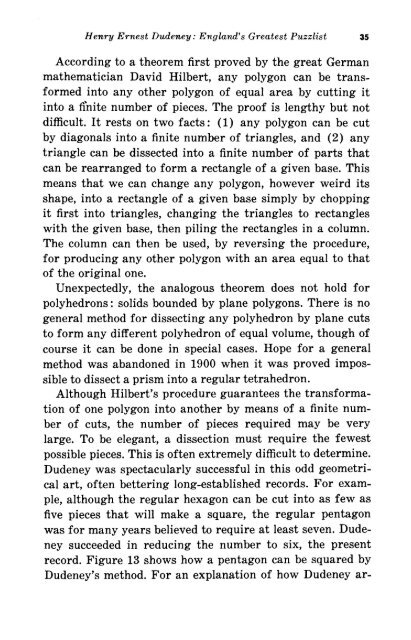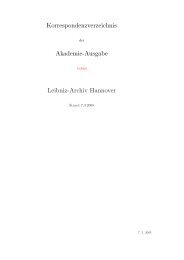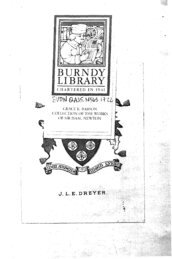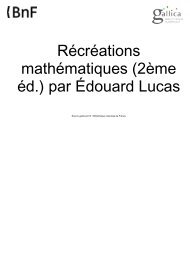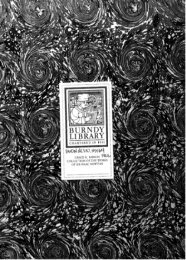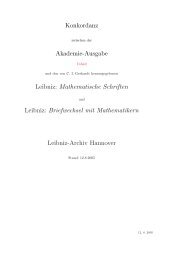The Second Book of Mathematical Puzzles and Diversions
The Second Book of Mathematical Puzzles and Diversions
The Second Book of Mathematical Puzzles and Diversions
Create successful ePaper yourself
Turn your PDF publications into a flip-book with our unique Google optimized e-Paper software.
Henry Ernest Dudeney: Engl<strong>and</strong>'s Greatest Puzzlist 35<br />
According to a theorem first proved by the great German<br />
mathematician David Hilbert, any polygon can be trans-<br />
formed into any other polygon <strong>of</strong> equal area by cutting it<br />
into a fihite number <strong>of</strong> pieces. <strong>The</strong> pro<strong>of</strong> is lengthy but not<br />
difficult. It rests on two facts: (1) any polygon can be cut<br />
by diagonals into a finite number <strong>of</strong> triangles, <strong>and</strong> (2) any<br />
triangle can be dissected into a finite number <strong>of</strong> parts that<br />
can be rearranged to form a rectangle <strong>of</strong> a given base. This<br />
means that we can change any polygon, however weird its<br />
shape, into a rectangle <strong>of</strong> a given base simply by chopping<br />
it first into triangles, changing the triangles to rectangles<br />
with the given base, then piling the rectangles in a column.<br />
<strong>The</strong> column can then be used, by reversing the procedure,<br />
for producing any other polygon with an area equal to that<br />
<strong>of</strong> the original one.<br />
Unexpectedly, the analogous theorem does not hold for<br />
polyhedrons: solids bounded by plane polygons. <strong>The</strong>re is no<br />
general method for dissecting any polyhedron by plane cuts<br />
to form any different polyhedron <strong>of</strong> equal volume, though <strong>of</strong><br />
course it can be done in special cases. Hope for a general<br />
method was ab<strong>and</strong>oned in 1900 when it was proved impos-<br />
sible to dissect a prism into a regular tetrahedron.<br />
Although Hilbert's procedure guarantees the transforma-<br />
tion <strong>of</strong> one polygon into another by means <strong>of</strong> a finite num-<br />
ber <strong>of</strong> cuts, the number <strong>of</strong> pieces required may be very<br />
large. To be elegant, a dissection must require the fewest<br />
possible pieces. This is <strong>of</strong>ten extremely difficult to determine.<br />
Dudeney was spectacularly successful in this odd geometri-<br />
cal art, <strong>of</strong>ten bettering long-established records. For exam-<br />
ple, although the regular hexagon can be cut into as few as<br />
five pieces that will make a square, the regular pentagon<br />
was for many years believed to require at least seven. Dude-<br />
ney succeeded in reducing the number to six, the present<br />
record. Figure 13 shows how a pentagon can be squared by<br />
Dudeney's method. For an explanation <strong>of</strong> how Dudeney ar-


